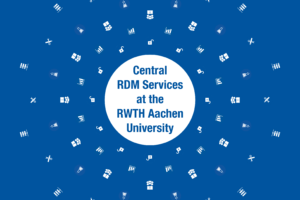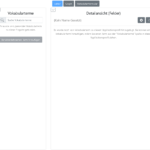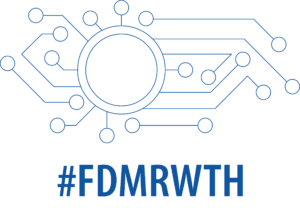This article is part of our series “Central RDM Services at RWTH Aachen“. It is intended to show our researchers – i.e. you – which RDM services are offered at RWTH Aachen University to support you in your research and data management. We talk to the people responsible for the services and collect all the information for you in the individual articles. In this article, we would like to introduce you to the RDM service “AIMS”.
Important Facts
- Official name of the service: AIMS – Application Profile Service
- Link to the homepage of the service: https://coscine.rwth-aachen.de/coscine/apps/aimsfrontend/#/editor
- Target group: Researchers
- Art: RDM platform
- Available in regular operation at RWTH Aachen University since the end of 2021
Example of an AIMS Usage Scenario
A researcher at RWTH plans to store their data with Coscine and wants this data to be provided with certain metadata. For example, with the author, the settings of the measuring instrument, the date of collection and so on. AIMS is used for this: You can either select application profiles (individual metadata profiles) that have been created by others and thematically match your own metadata. Or new application profiles can be created. AIMS offers a wide range of settings: Lists can be created, the required metadata fields specified, field descriptions added and even regular expressions used to validate metadata fields.
AIMS is a sub-service of Coscine. It offers you – as a researcher – the opportunity to create application profiles that help you to store suitable metadata for your research data in Coscine in accordance with the FAIR criteria. AIMS supports you in structuring and describing metadata for scientific data. AIMS also checks for syntactic correctness. Application profiles are written in Coscine in standardized formats (SHACL) and transferred to the future-oriented “Resource Description Framework” (RDF data format), which makes them interoperable and machine-readable. You can find out more about these formats at the end of the article.
You can download your own application profiles in RDF data format and send them to Coscine for publication and subsequent use. Before publication, the Coscine and RDM team will check the technical functionality.
Who Is Entitled to Use AIMS?
AIMS is available to all researchers who work with Coscine in their projects. You must provide a personal Coscine user token, which allows you to publish your application profile directly. Without a user token, an application profile can only be saved locally. You can find out more about creating a user token at the end of this article.
Context to the Bigger Picture: What Purpose Does AIMS Serve in Modern Scientific Practice? What Function Does the Service Have in Modern Knowledge Management?
In modern scientific practice, AIMS enables researchers to create and manage application profiles easily and effectively. Application profiles provide a standardized method for describing and managing metadata, which significantly improves the findability and reusability of data and facilitates compliance with the FAIR principles. AIMS offers many advantages by standardizing the structuring and description of research data and thus promoting reuse and integration.
Further Information
AIMS is an open-source platform and thrives on community participation. If you have any questions or suggestions, please contact the Servicedesk with the subject line “AIMS”: We will be happy to help you.
All Important Pages at a Glance
- AIMS: https://coscine.rwth-aachen.de/coscine/apps/aimsfrontend/#/editor
- Documentation: https://docs.coscine.de/de/metadata/generator/about/
- AIMS video tutorials: https://docs.coscine.de/de/metadata/generator/guide/
- Coscine: https: //about.coscine.de/faq/
- Newsletter Coscine: https://lists.rwth-aachen.de/postorius/lists/coscine.lists.rwth-aachen.de/
- Regular expressions page: https: //regexr.com/
- What is SHACL: https: //www.w3.org/TR/shacl/
- What is RDF: https://www.w3.org/RDF/
The information was kindly provided by Dr. Kseniia Dukkart. She is a data steward at SFB/TRR 219, part of the central RDM team at RWTH Aachen University,
and advises researchers on topics including the use of AIMS.







Leave a Reply
You must be logged in to post a comment.